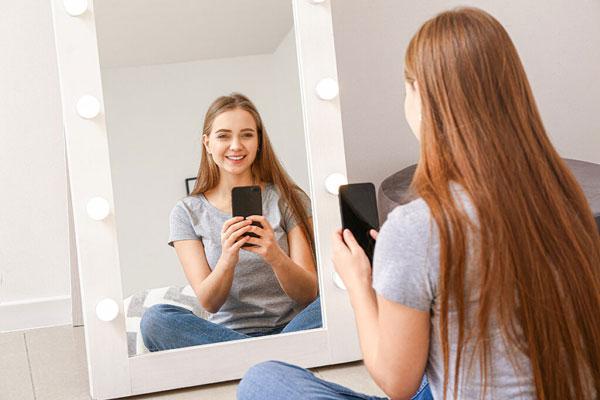In today’s world, the term thirst trap has gained quite a bit of attention, especially on social media platforms. It usually refers to posts designed to garner maximum engagement and may include displaying one’s body and suggestive captions.
Thus, we’ll outline what the thirst trap is, its multiple forms, elaborate on the pros and cons of creating such content, and analyse its impact on teenagers. Also, offer insight and practical guidance for parents trying to mitigate negative social media effects on their children and teenagers. So keep reading!
What does thirst trap mean?
Thirst traps are a slang term which describes a form of content that is designed to capture the user’s attention, garner likes, and even comments. Users are not trying to build meaningful relationships, they may attract sexual attention or use it to elicit flirting to feel good about themselves. You primarily came across such posts on Instagram, Snapchat and TikTok.
The aim of the user’s content-sharing social media platforms was to help people get in touch with each other. Posting content that reflects self-confidence is advisable, while seeking social acceptance is unhealthy.
What is considered a thirst trap?
As we scroll through social pages, we come across such posts which we just can’t help but pause to admire. It could be a striking outfit, an amusing caption, or most likely an impressive pose.
Types of thirst traps:
i. Bold selfies: Self-portraits taken with zoom filters, which only show the face are very popular. Expressionless selfies are a form of bold selfies. Such selfies proclaim “Look at me” sans the need for any utterance.
ii. Revealing outfits: Another form of attention-catching self-portraits includes revealed outfits. Wearing a swimsuit or any tight apparel that exposes parts of the body normally covered is usually a clear indicator of a thirst trap.
iii. Mirror pictures: A new category of video and photos is the “taken in front of a mirror” photo. Such poses, apart from showing an outfit, display a considerable amount of flesh and are able to show the body from the waist down.



iv. Fun and flirty captions: Furthermore, adding fun and flirty captions to straightforward images enhances their charm. People post photos and add captions like ‘Just woke up like this’ and ‘So cute’. Both of these are witty and have a tinge of humour at the same time.
In any of the cases stated above, there is one overarching objective that is common to all, and that is attention. Thus, one gains followers with increased thumbs up, love emojis, and compliments.
Why do people make thirst traps?
As we can see, the purpose of the thirst trap is to confirm the fact that people are valued and acknowledged. Let us explore further.
Increased self-esteem: It’s common knowledge that when people admire you, your confidence goes up. So, self-thoughts, which are very important, can push someone to share a thirst trap.
Picture this: it’s a beautiful day, and you are glowing with happiness because a new dress makes you feel good. So, an urge of self-esteem gives thrust to the displays made online, and in turn, the esteem gives ample appreciation which, in the end works towards better self-esteem.
For entertainment reasons: Some may opt to upload thirst traps purely out of boredom and for fun rather.
To cultivate relationships: Lastly, sharing of thirst traps does help in establishing connections and building other relationships. Moreover, your friends may like your posts and share compliments, in a way, showing support too. Such types of interactions foster friendships and promote societal relations.
Is a thirst trap a compliment?
Not exactly, a thirst trap isn’t a compliment by itself. But as mentioned earlier, it’s a photo or videos which people post on social media platforms to get compliments from others. There are different reasons why thirst traps are posted. Most of the time, when you post any kind of thirst trap, it is to get some great comments and praises on your outfit or looks.
However, there are different extremes to comments that you need to understand. Suppose someone comments on your post thirst trap, jokingly. Then he or she actually considers you beautiful.
On the other hand, if someone uses a rude or judgmental comment, it means you are getting mocked because of gaining attention in a begging manner. Hence, while enjoying the thirst trap so-called appreciation, users also get criticism.
Is posting thirst traps a red flag?
Thirst traps are posted for several reasons, and it is not necessarily a negative thing. For example, with regard to a selfie, someone may simply want to feel good about how they look. In this case of posting thirst traps, many people do it to seek attention from their friends or revel in their own reflection.
However, if someone perpetually posts selfies of their face or body in ways that seem to beg for likes and compliments, it does indicate there is a problem. Such an individual could be dealing with serious attention deficit issues or a lack of self-love love which often leads to destructive behaviour. In a relationship, this is bound to make a partner insecure.
In short, the posting thirst traps should not be immediately flagged as dangerous behaviour. Instead, it depends on the frequency and rationale behind such behaviour.
How to identify a thirst trap?
Given the proper information, identifying a thirst trap can be relatively simple. Here are a few pointers for you to consider.
- Revealing clothing: As with any fashion trend, thoughts and cultures tend to favour garments that reveal certain areas of the body. Any outfit that goes skin-deep or is tighter than usual is bound to garner attention.
- There are a good number of people who appreciate positive attention for their skin-baring outfits. In most instances, these outfits receive more compliments than critiques.
- Suggestive poses: Body movements are yet another possible solution in trying to piece together clues about the mystery of thirst traps. If a person adopts a flirty or playful stance, chances are they are attempting to capture thirst-trap moments.
- Captions seeking justification: Also, pay close attention to what the thumbnails and captions claim. For instance, captions like “Enjoy” Incite passive users to engage with posts.
- Excessive use of filters: Boundless effort on editing can make a person “perfected” through showcasing selective features, one oh so pretty. This is typically done to improve the image’s attention-grabbing potential or simply make the upload better visually.
To finish, every caption or image bearing time investment towards a social media presence showcases a “thirst trap” baited for validation or attraction. Specifically, as we have analysed so far, the act of posting does not always have ulterior motives; sometimes it’s emerging as a show of self-appreciation.
Are thirst traps good or bad?
Posting thirst traps, like anything else, comes with pros and cons. Though let’s break it down further.
The pros of posting thirst traps
- Self-esteem booster: The self-esteem aspect has the most notoriety, which stems from posting a thirst trap. The attention, compliments, and recognition received can work wonders for their psyche.
- A way to express yourself: In addition, it is a fun way to express your emotions. Whether you’ve experienced a glow up or you simply feel amazing about yourself, posting a photo celebrating such moments allows people to connect with that positivity and confidence.
The cons of posting thirst traps
- Increased social media use: To be perceived as a focus of interest usually leads to mindless scrolling. For those seeking to grab attention, this lack of enrichment not only disturbs their real-life activities but also impacts their mental and physical health.
- Unfortunate focus: As mentioned before, the aims behind a poster receiving attention can result in the poster feeling stressed.
- Self esteem risk: Moreover, self-depiction in contrast to reality, brings with it the risk of a lack of social acceptance, resulting in drastic modifications of personal extremities.
Should teens be exposed to the thirst trap?
The concept of thirst traps tends to have an adverse impact on the self-image and social interactions of teenagers. Remember that children have an innate quest for attentional self-admiration. As a parent, if you do spend time with the child and shower them with praise, then they resort to the internet.
Thus, on their social media accounts, they are sharing audacious pictures (thirst traps), and in such situations, the attention received comes in the form of likes and comments. Nonetheless, if the desired attention goes unacknowledged, it results in social anxiety and depression.
For this reason, they put in a lot of effort to share photos and videos since they capture elegance, status, and beauty, and interaction takes a back seat in life. In addition to distracting youth from real-life priorities, social standing misleads the youth to fostering aimless, dependent relationships.
As for suggestive and sexualized imagery, they come with ethical issues. Due to their age, teenagers are impressionable, and this opens the door to predators, online trolls, cyberbullies, and any other malicious individual who seeks to destroy the child’s emotional and self-image stability. Teens require constructive guidance on the internet so they are able to express themselves without fetters.
How to protect your teens from inappropriate social media impacts?
The strategies outlined below can help your child manage the risk posed by social media!
❖Encourage open discussion: Have honest discussions about thirst-trapping and other relevant social media activities. In addition, prioritise engaging with teenagers, valuing their presence. They will not feel insecure and will not resort to social media for attention if you give them time. Also, emphasise the fact that seeking validation online suggests self-image issues.
❖Set boundaries: Social media has its rules to follow. Sit down with your child and explain the rules related to sharing content. Help them understand why it is important to think before posting anything that could be embarrassing in the future.
❖Consider using parental control software. Also, you may want to think about acquiring parental monitoring, because it will assist in tracking your children on a more intimate level. FlashGet Kids Parental control acts like your personal virtual assistant, which notifies you about your child’s digital activities on the spot.



For example, Snapshot allows you to take screenshot of their phone. Notifications and keyword detection can track what they share and post on different social platforms. Furthermore, these restrictions allow social media to shield children from the view of inappropriate and distracting material, keeping their attention away from sensitive issues as opposed to protecting them from those issues.
Given these points, you can help your teenager navigate away from social media traps that could lead to poor body image, directing them towards more productive ways to engage with social media.

